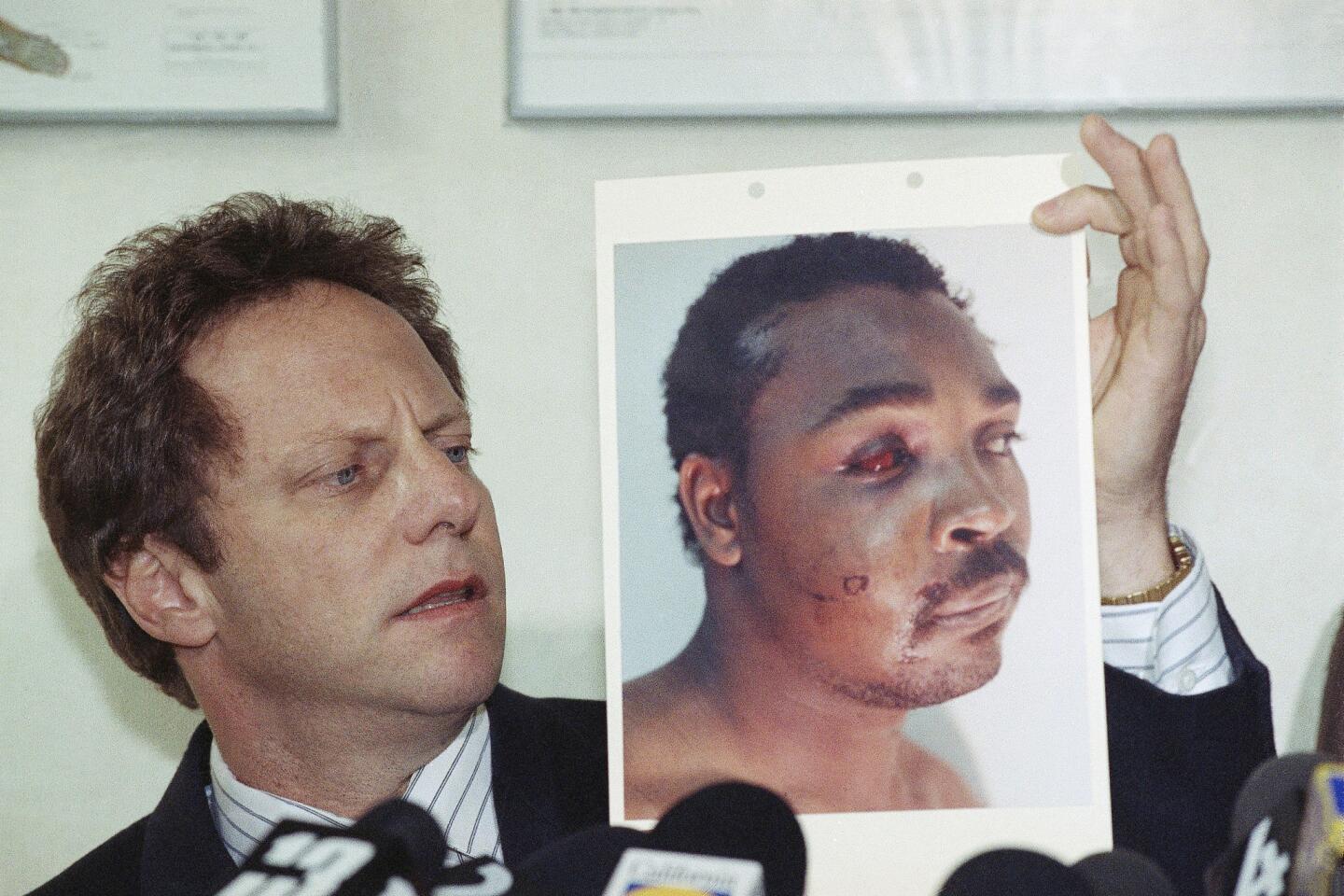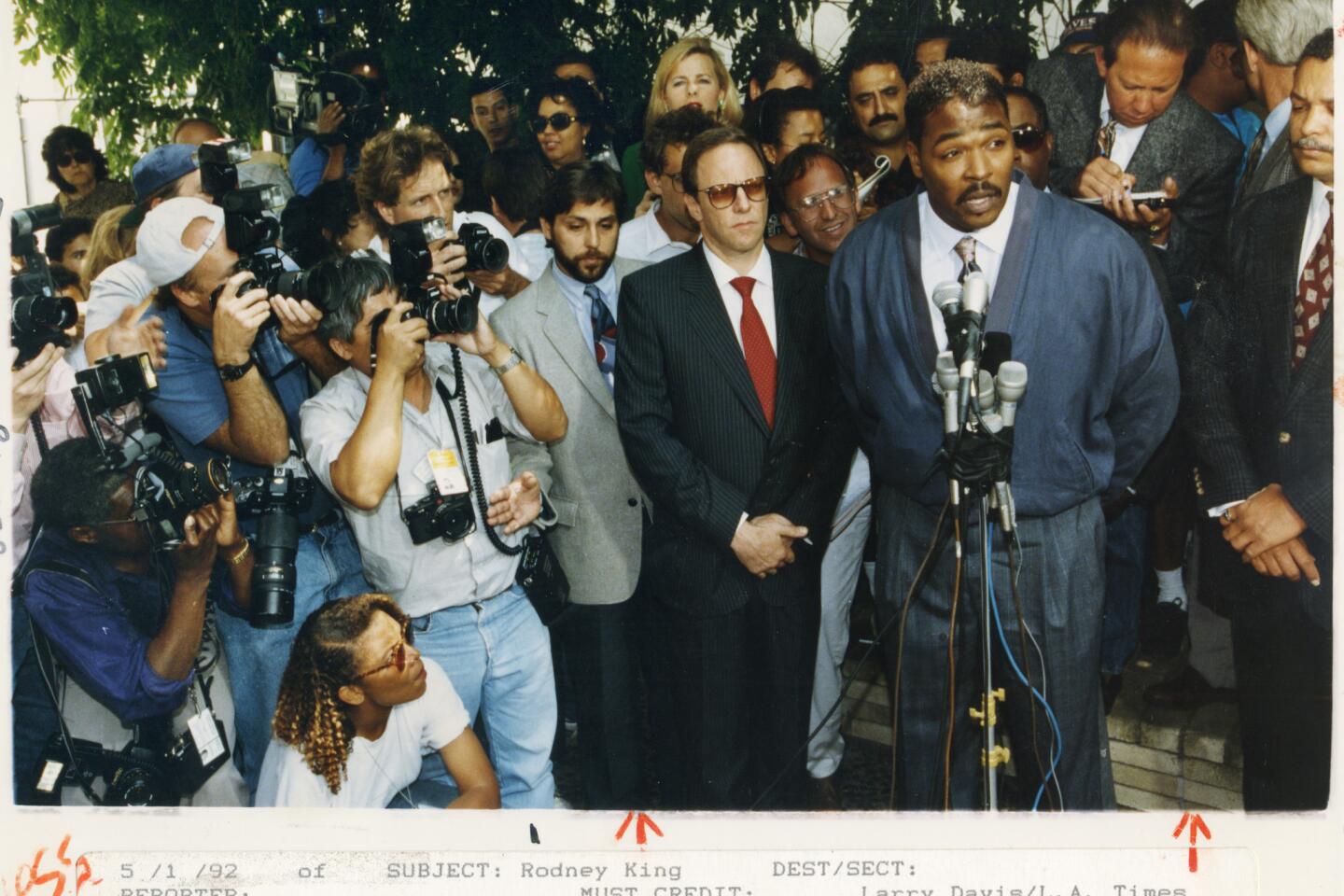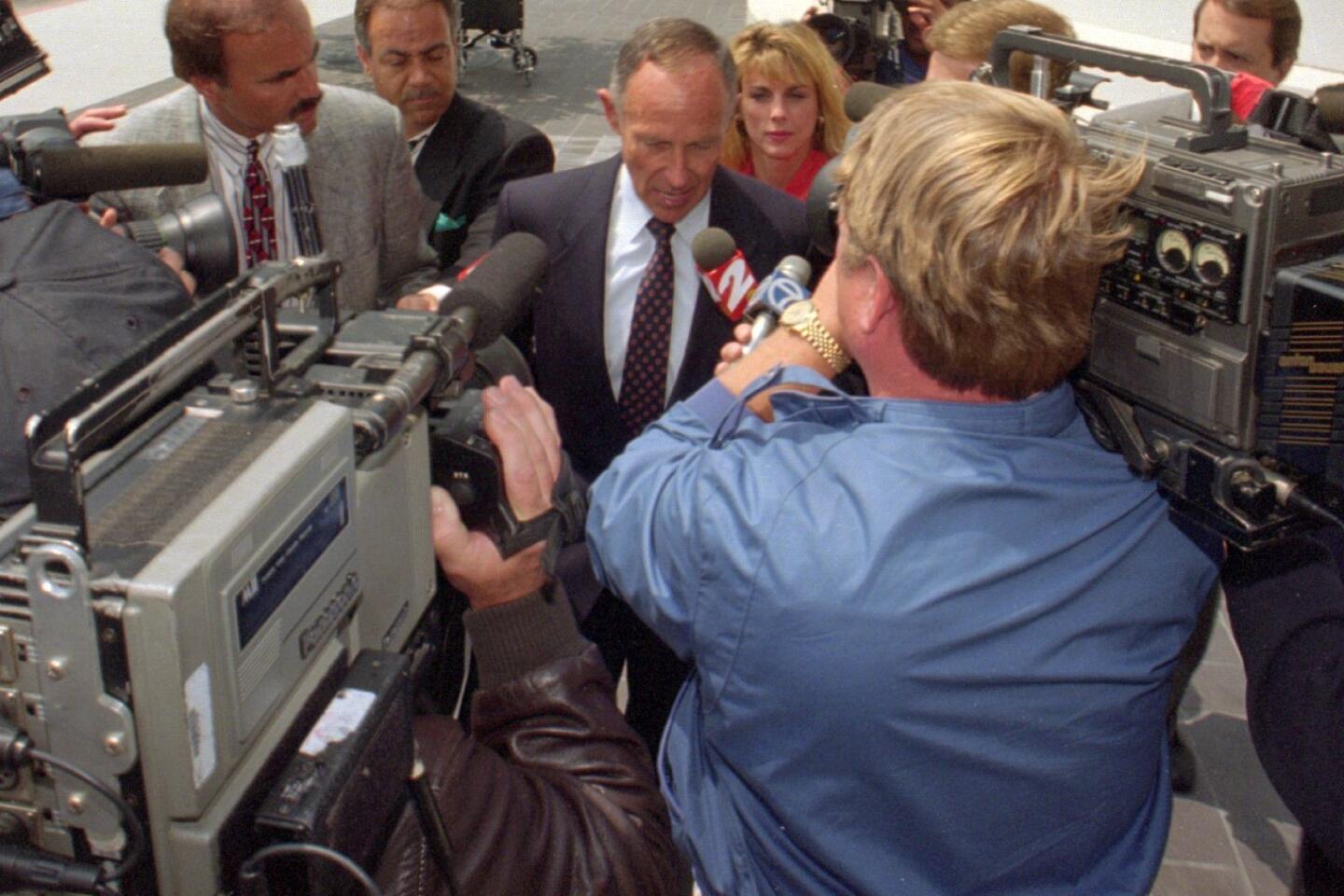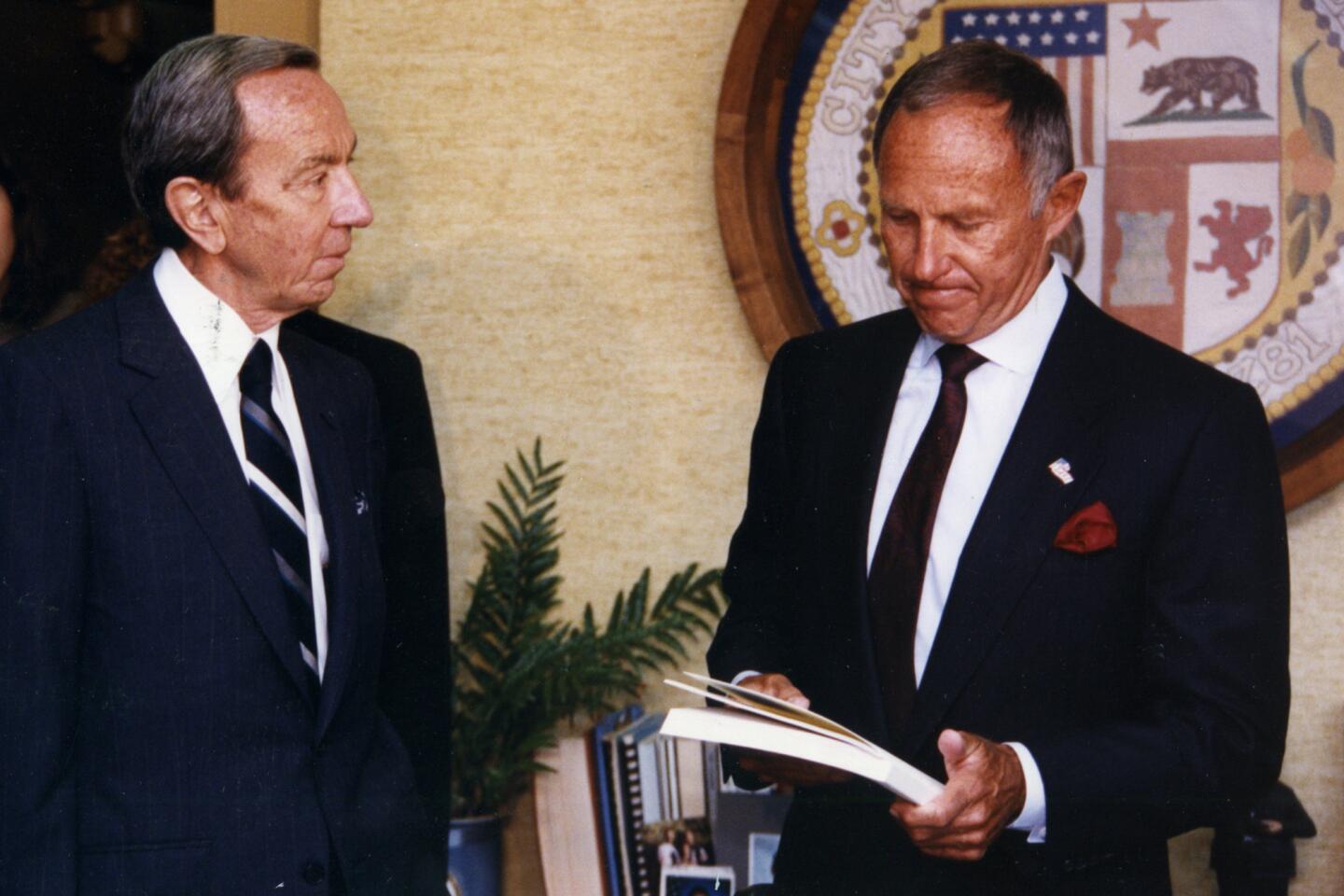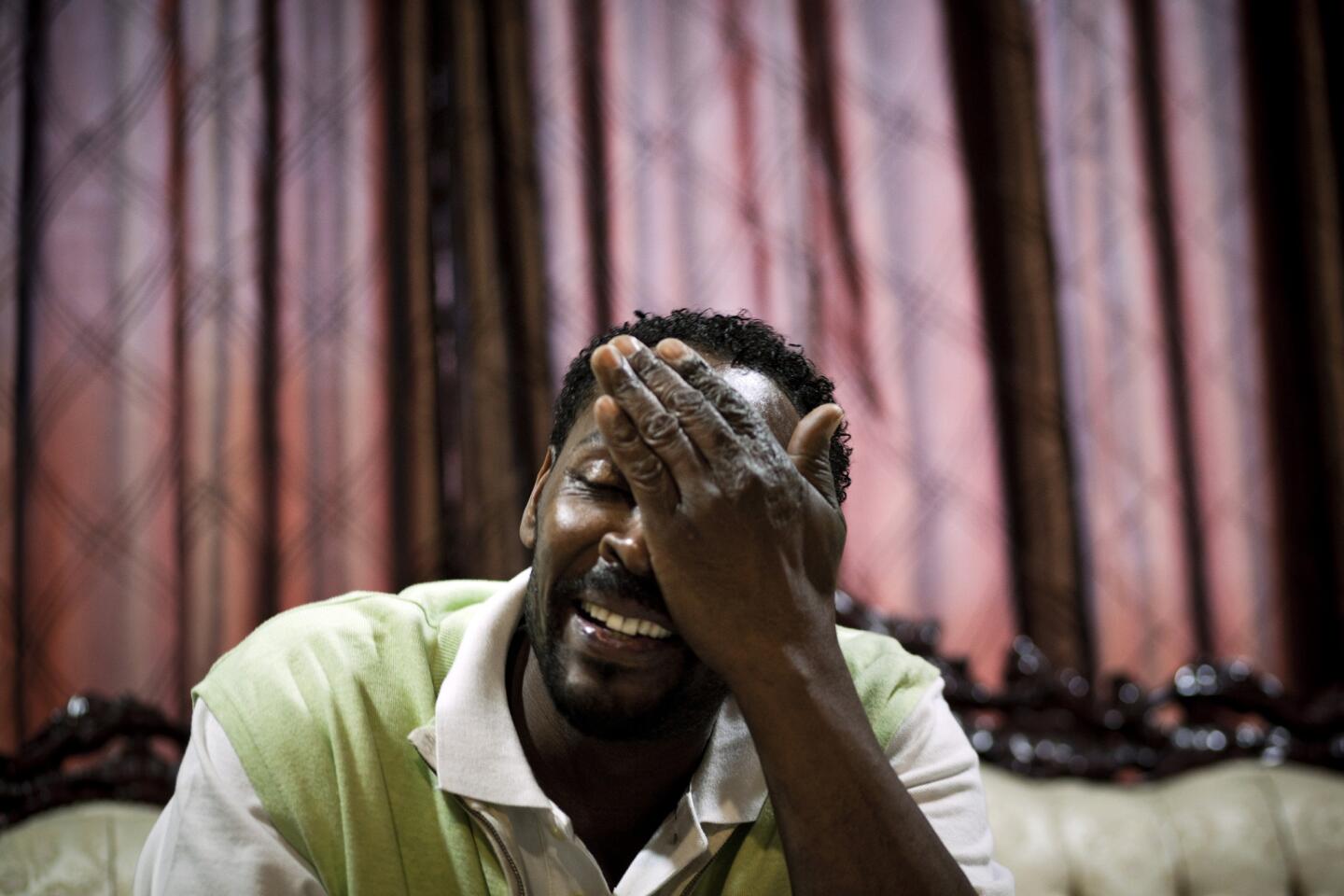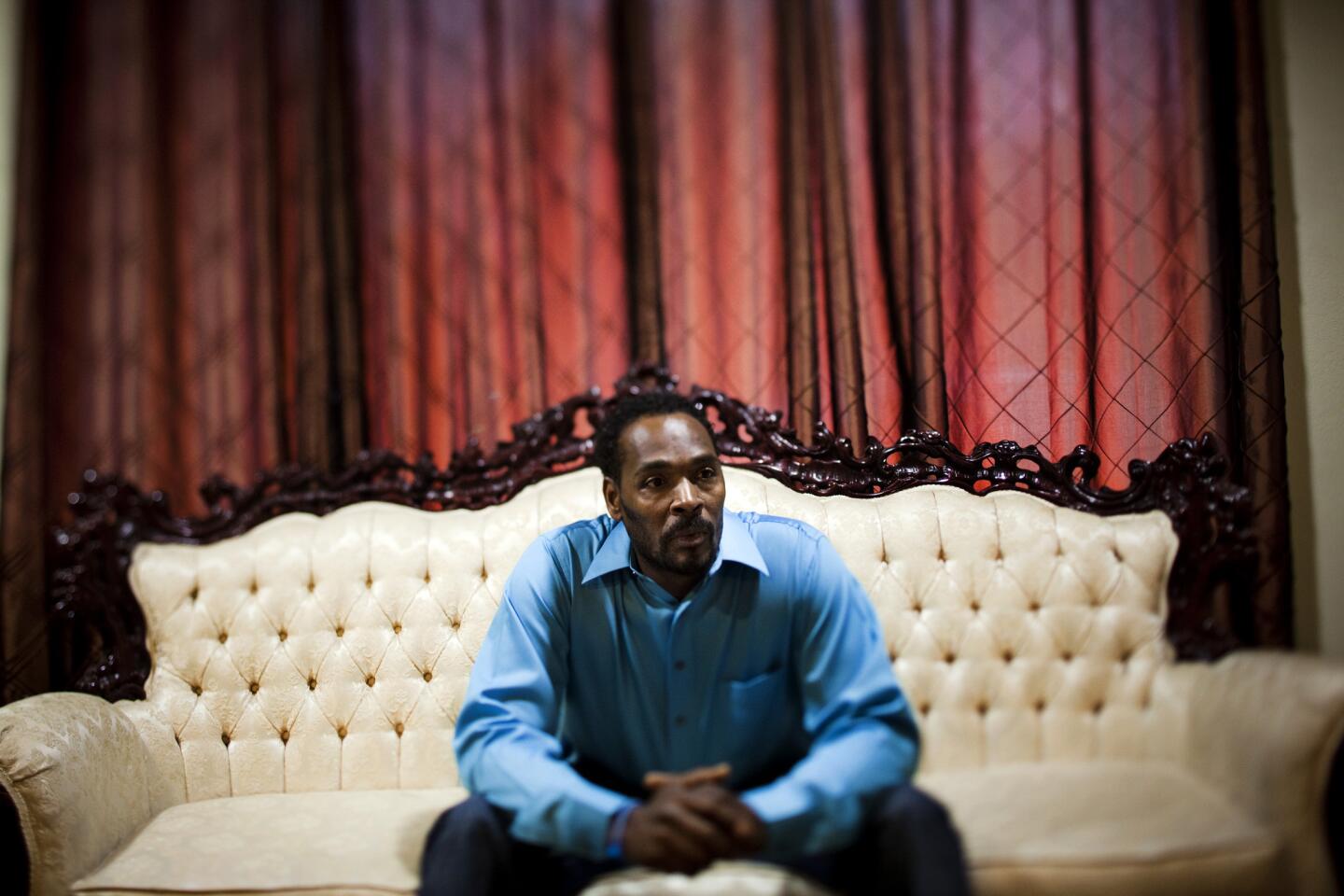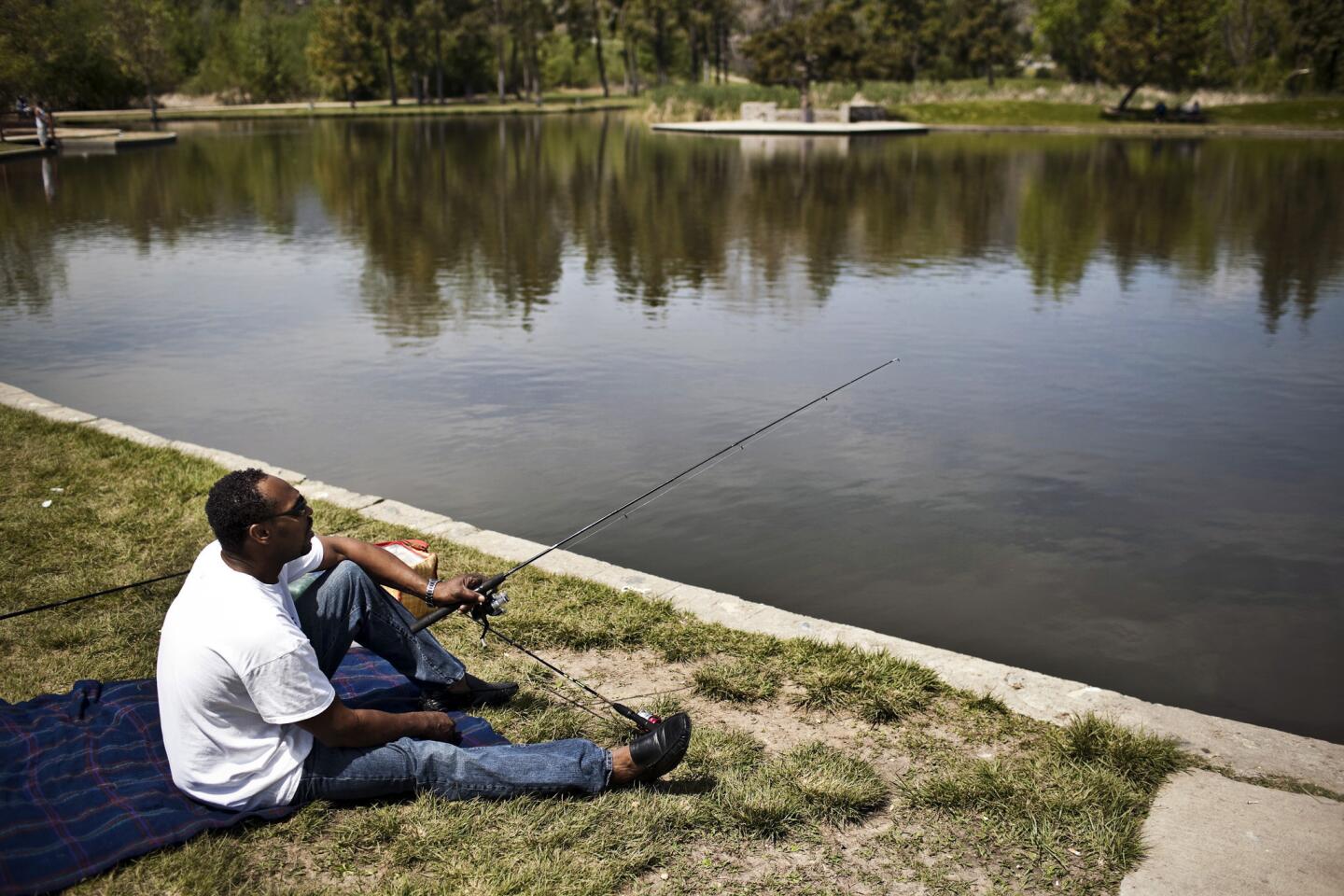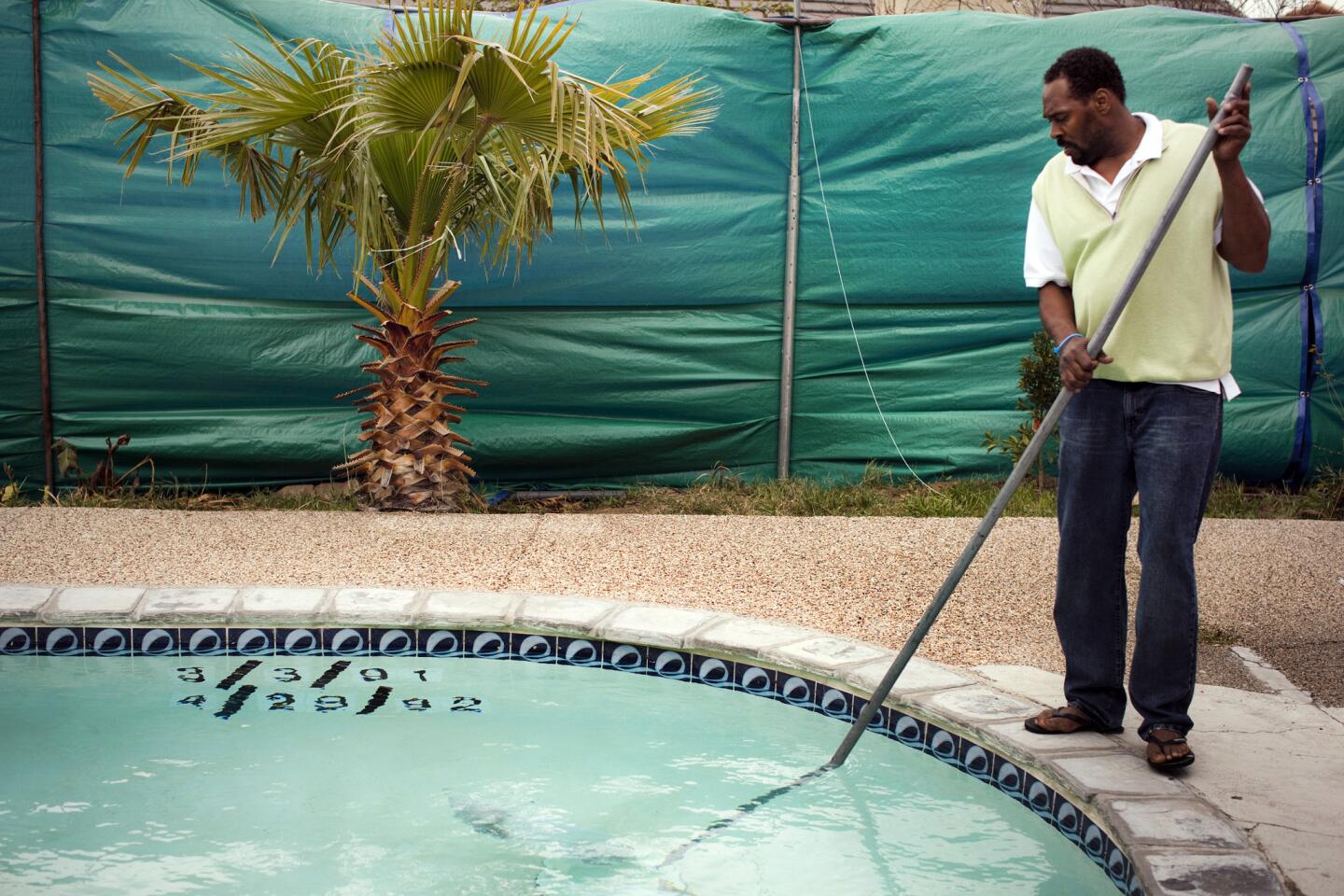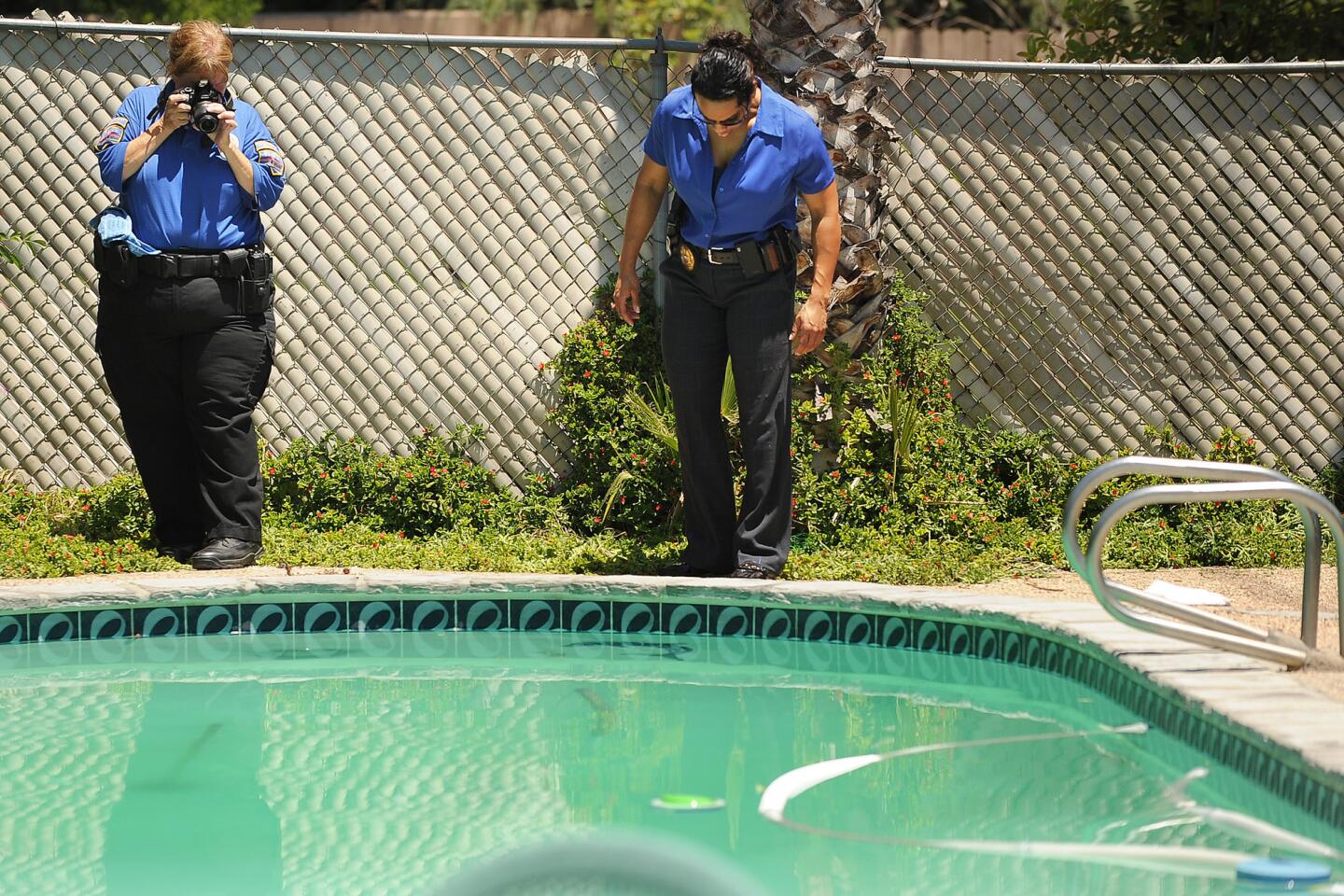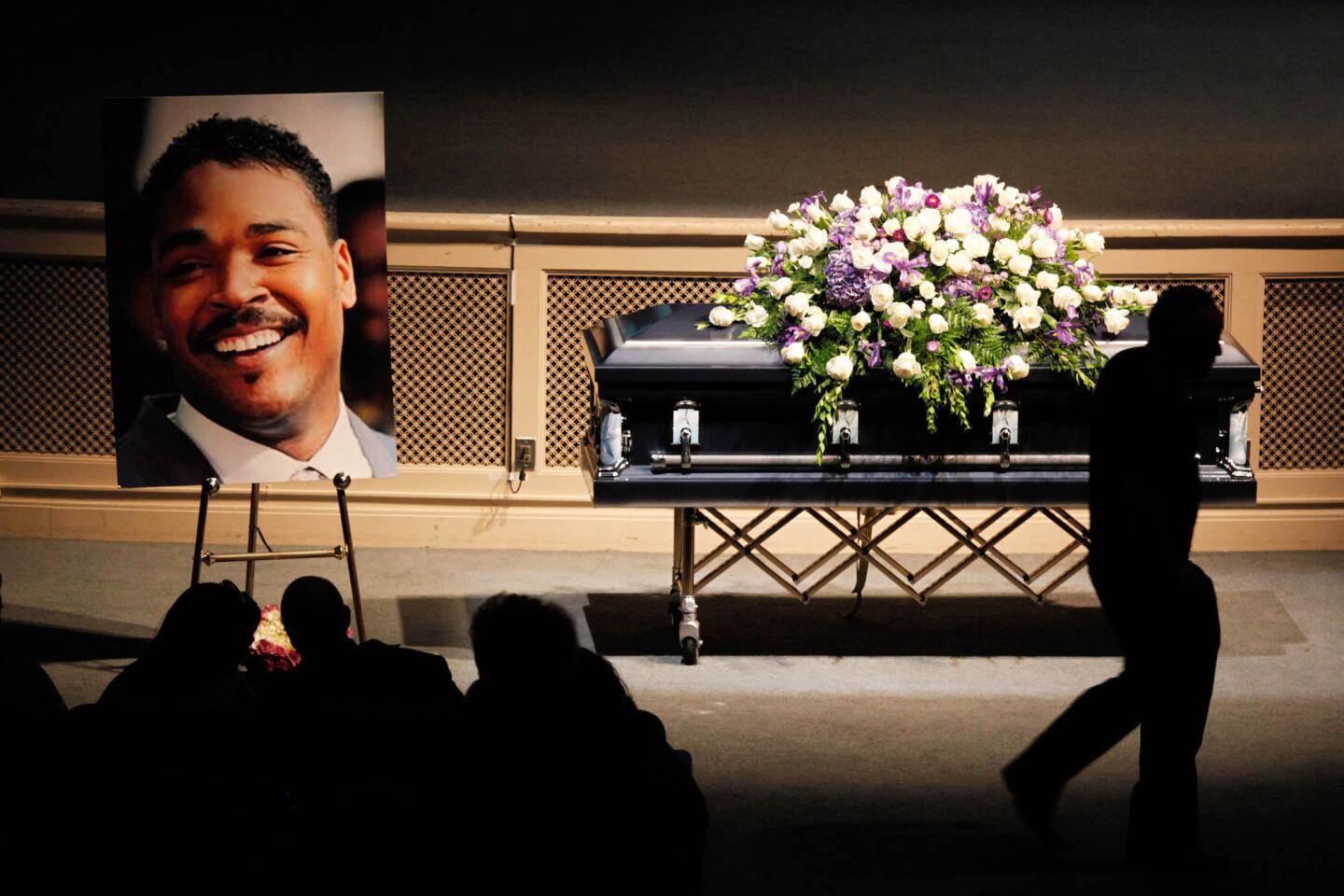From the Archives: King case aftermath: A city in crisis
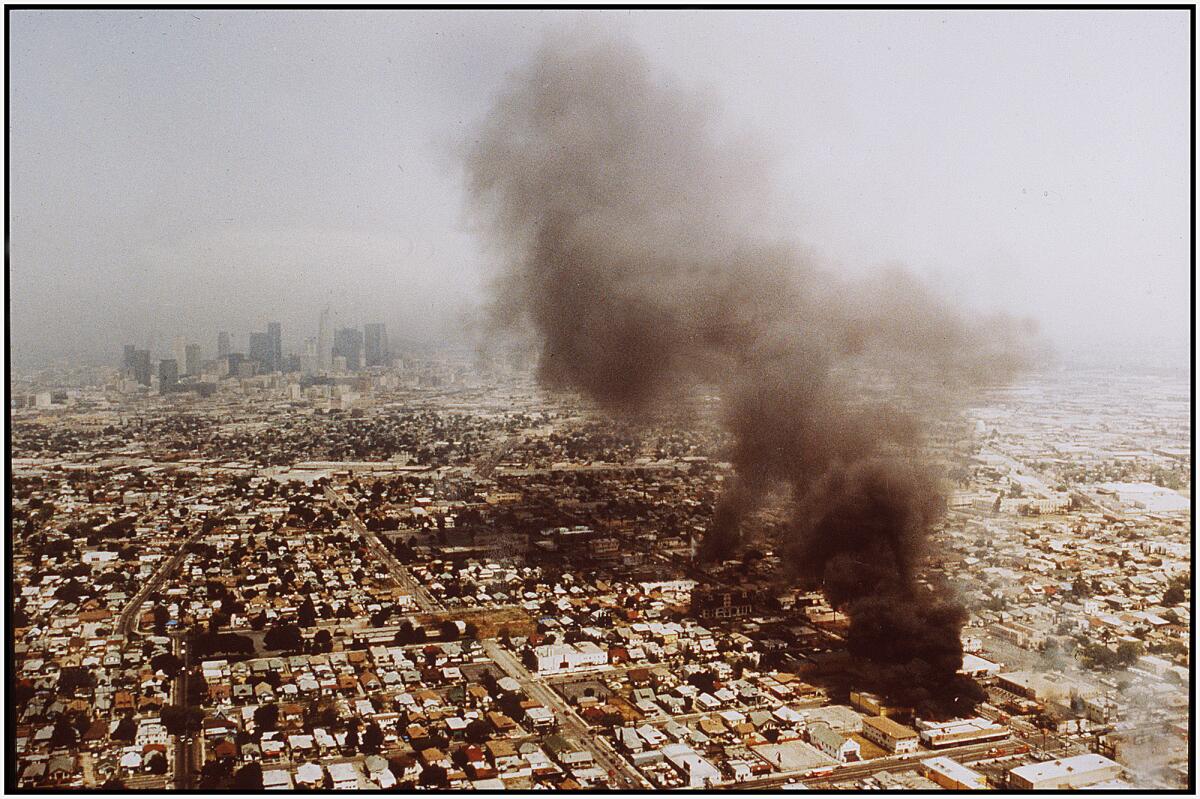
Fires burn out of control on the second day of rioting in Los Angeles following announcement of the Rodney King verdicts.
- Share via
National Guard troops and police wrestled to gain control of riot-ravaged neighborhoods across Los Angeles on Friday amid indications that authorities were gaining the upper hand for the first time in three days of the worst urban unrest in Los Angeles history.
In a city that has long boasted about the richness of its Third World flavor, on Friday it had come to mirror the worst of some war-torn neighbors to the south. Military equipment rolled down boulevards, men with automatic weapons stood sentry and a dusk-to-dawn curfew kept residents indoors.
President Bush ordered 4,500 military troops into Los Angeles to help quell the violence. He also sent 1,000 riot-trained federal law officers to the city--including 200 members of the U.S. Marshal’s special operations group that was sent to Panama in 1990 to take dictator Manuel Noriega into custody. Federal and local officials said the muscle-flexing, decried as being long overdue by many in devastated areas of the city, was meant to “ensure the safety of the streets” before the weekend.
Throughout the day, law enforcement and city officials cautiously predicted that the tide had turned against the rioters, with fewer fires reported, more looters being jailed and many streets returning to relative calm in the hardest-hit areas of South Los Angeles. But some violence and looting continued in sporadic bursts across the greater Los Angeles area.
“I’m not going to relax and assume its over,” Mayor Tom Bradley said Friday night in a televised address. ‘I don’t believe it’s over. I want us to show by the massive . . . force we are putting on the streets here that we are determined to maintain control.”
In other major developments:
* Police reports placed the number of deaths at 40 with at least 11 killed by law enforcement officers. An additional 1,899 injuries have been reported, including three police officers, since the violence erupted after Wednesday’s not guilty verdicts in the case of four Los Angeles police officers charged with beating black motorist Rodney G. King.
* The death toll, combined with property damage estimates exceeding $500 million, added an inauspicious historic dimension to the three-day disturbance: The violence eclipsed the 1965 Watts riots as Los Angeles’ costliest and deadliest urban disorder. During the five days of the Watts riots, 34 died. The worst riots in U.S. history occurred in Detroit in 1967, leaving 43 dead and more than 2,000 injured.
* In a highly visible show of force, hundreds of armed guardsmen moved into trouble spots, maintaining calm at post offices and grocery stores as thousands of panicked residents rushed to pick up Social Security and welfare checks and prepared for an uncertain weekend.
* By late Friday afternoon, 5,200 people had been arrested countywide. In the rush to make room for those who had been arrested, officials moved about 1,200 inmates from county jails to state prisons, forgoing the normally cumbersome paperwork process.
* Officials in Washington indicated that the U.S. Justice Department is likely to seek criminal indictments of the four officers involved in the March 3, 1991, beating of King. In a highly unusual announcement, the officials said that the department has convened a federal grand jury in the case and that subpoenas had been issued Friday “in furtherance” of the grand jury probe.
* King, the Altadena motorist whose name has been the haunting rallying cry of rioters, appealed for calm and denounced the mayhem. “It’s just not right,” he said. “It’s not right, and it’s not gonna change anything.”
* Business leaders and economists predicted that the civil strife is likely to extend and worsen Southern California’s battered economy. With an estimated 4,536 fires raging throughout the Los Angeles area since Wednesday, thousands of businesses have closed and countless workers have been idled. Continuing disruptions will hurt tourism, retailing and service industries; put an added burden on banks and other financial institutions, and strain city, county and state budgets.
* Pope John Paul II, described as “deeply saddened” by the rioting, offered prayers for “the restoration of civil harmony and a renewed spirit for solidarity” in Los Angeles in a faxed message to Cardinal Roger M. Mahony.
The Violence
The overnight curfew in Los Angeles and neighboring areas--extended by officials for a third day into this morning--left much of the smoldering city in a nervous calm. Freeways and surface streets were almost deserted, as were restaurants, theaters and sporting arenas. In some areas, only the homeless--with nowhere else to turn--remained outdoors.
Even so, daybreak on Friday was regarded in some neighborhoods only as an invitation to renew the looting, arson and shooting. A thick pall of smoke still hung over much of the Los Angeles Basin, fires burned from Hollywood to South Los Angeles, and new outbreaks of violence erupted in Long Beach, the Harbor and Mid-City areas, and in the San Fernando Valley community of Panorama City.
Three LAPD officers were fired on by a sniper about 7:30 a.m. near Vermont and Manchester, but escaped with superficial injuries.
The three officers were driving south on Vermont when a sniper armed with an AK-47 assault style rifle opened fire. Police in a second patrol car saw the shooting and returned the fire, hitting the assailant once in the head. The suspect, who was conscious and talking with officers as he was taken into custody, was taken to a hospital.
The three officers, Michael Strawberry--brother of Los Angeles Dodger Darryl Strawberry--Mark Ramirez and Charles Choe, were treated at Daniel Freeman Memorial Hospital and released with what LAPD spokesman called extremely minor injuries.
Later in the night, police reported that snipers fired at a plainclothes officer driving on the Harbor Freeway, missing him.
In Long Beach, battered Thursday night by widespread looting and scores of fires, residents awoke Friday to smoke-filled skies, charred buildings and streets littered with glass and abandoned loot.
In block after block, store owners busily hammered pieces of plywood over windows and many said they were spending Friday night in their shops, guns at their sides.
Long Beach officials were hoping that police reinforcements, including the arrival of National Guard troops in the city, would help them keep control. “We’ve come through a long, dark night and we believe we have a handle on it and we will be able to keep a handle on it,” City Manager James Hankla said at a midday news conference.
Hankla had declared a state of emergency Thursday, and imposed a dusk-to-dawn curfew. At one point during the evening, fire reports were coming in every three minutes. By late afternoon Friday, 218 fires had been reported, 87 of which were serious. About 200 injuries had been reported, 51 of them serious, and 302 people had been arrested.
In the San Fernando Valley, a Times reporter was beaten and shot at by half a dozen looters outside a North Hills delicatessen Friday afternoon.
Jim Herron Zamora was interviewing shopkeepers along the 14600 block of Parthenia Avenue when the looting began. While taking notes in a parking lot, he was surrounded and told to surrender his notebook. A struggle followed.
“Somebody to my left said: ‘Get out of the way. Let me get a clear shot,’ ” Zamora said. “I vaguely saw the barrel of a gun. I heard it go off.”
The errant shot scared off the crowd, allowing Zamora to escape.
Vermont Avenue was one of the hardest-hit streets in Los Angeles. For a 10-mile stretch from Santa Monica Boulevard in Hollywood to Manchester Boulevard in South Los Angeles, the scene was one of devastation.
Entire blocks were burned out. Traffic signals no longer worked. Glass littered the streets. Police in riot gear, joined by National Guard units, stood guard at two post offices while thousands waited in line to get their government benefit checks.
At least one fire was set Friday along the street--in an abandoned beauty supply store at 57th and Vermont. A volunteer federal firefighter, who normally spends his days working as a fire inspector, struggled to put out the blaze with a lone fire hose until reinforcements from the Los Angeles Fire Department arrived. By that time, the building was fully engulfed, as was the adjacent shop.
In all, 11 people were killed in encounters with police, four were burned, one beaten, one stabbed and the rest were slain by gunshots that rang out sporadically in neighborhoods from Lennox to Long Beach. Most of the victims were black, though at least nine were Latino, three Anglo and one Asian-American.
Good Samaritans
But for every horror story of fire and violence, there seemed to be a tale of neighborliness or heroism.
Cleanup efforts were under way along the northern part of Vermont Avenue, in the Mid-City, Mid-Wilshire and Hollywood districts. There, volunteers from various churches, supplied with brooms, shovels and gloves, swept up glass and boarded broken windows.
On Vermont, there was an incredible reversal of fortunes. Thursday night’s looters were replaced by Friday morning’s cleaning crews. A woman pedaled her bicycle up Vermont with a broom and dustpan fastened to the handlebars.
Cars cruised Vermont and occupants waved, honked horns and gave the peace sign to those cleaning up. In a city rife with racial hostility, color and ethnicity seemed not to matter.
“I especially wanted to help the Koreans,” said volunteer Elmore Dingle, 31, who is black. “I don’t want them to think so negatively about blacks. The violence last night wasn’t real. This is real.”
Not all the heroics, however, had happy endings.
In Inglewood, a 24-year-old good Samaritan died trying to save a burning store near his home. Kevin Evanshen died early Friday morning after plunging through a weakened roof on Inglewood Boulevard while helping put out flames in a looted check-cashing store, police said.
Evanshen had climbed a ladder onto the single-story roof to pour water through a burning hole when the roof gave way. He was helping the owner of a neighboring television store, which had been looted along with several other businesses in the complex of stores at Inglewood and Braddock Drive in the Del Rey section of Los Angeles, said LAPD Detective Bob Nelson.
“The guy was really trying and when he got up on that roof, he probably didn’t know how bad that fire was below him,” Nelson said.
Nelson said investigators concluded that the fire was set deliberately and Evanshen’s death was being treated as a homicide. Police said it was the first time in the three days of rioting that a good Samaritan had been killed fighting a fire.
Other deaths ranged from opportunistic gang slayings to police shootouts with suspected thieves and snipers. The coroner’s office also received an increasing number of burn victims as bodies were reclaimed from the rubble of hundreds of charred buildings.
The Fears Remain High
People were able to move around in relative calm Friday--for the first time in two days--thanks in large part to the heightened military presence.
National Guard units were scattered throughout the city, and where the units were in place, residents were glad to see them. Many said the troops were a welcome sight compared to the seemingly ineffectual officers of the Los Angeles Police Department.
But where there were no Guard members present, there was fear, anguish and outrage.
“This morning, we came and there were none here,” said Victor Perez, who brought his son to a burned-out mall at Martin Luther King Jr. Boulevard and Vermont. The two were sweeping the area clean, hoping others would follow their lead and stop the destruction.
“If some guards were here, maybe this wouldn’t have happened,” Perez added.
A few blocks away, a dozen Guard troops were massed with local law enforcement officials, protecting a ransacked ABC Market.
“We experienced some frustration getting them here,” said LAPD Cmdr. Michael Bostic, who had Guard units under his command at the market. “Our frustration was that we needed the extra help, but we’re starting to get it now.”
J.W. Johnson stood in the shadow of burned-out doctor’s office, feeling safe for the first time in days. The National Guard was massing in the parking lot of the ABC Market at Vermont and Vernon, and Johnson, a retired railroad worker, said he believed that the Guard was his community’s best hope for ending the violence.
But even as they welcomed the troops, Johnson and others complained that it had taken too long for them for arrive. During the delay, Johnson said, store after store was pillaged and torched.
Columns of smoke still rose from the string of small shops across Vermont from the market.
“If they had gotten here yesterday, they could have saved this,” he said. “Now it’s gone. Where am I going to shop? Where are all these people going to shop?”
Joe Kazazian, owner of an auto repair shop and U-Haul franchise on Melrose Avenue in Hollywood was also angry about the slow response, even though is business had not been damaged.
“It only took them 24 hours to occupy Panama,” he complained. “They should have sent the troops right away and give them orders to shoot.”
At City Hall, some city officials expressed similar frustration with the slow response. Mayor Tom Bradley told reporters he requested the federal military assistance because of delays in the dispatching of up 4,000 Guard troops he had requested when rioting began Wednesday.
“That was one of the turning points in our decision to call on the President,” Bradley said. Deputy Mayor Mark Fabiani was more blunt in an interview later. “The bottom line is that the mayor was dissatisfied with the speed of deployment of National Guardsmen,” Fabiani said.
The officers sent by the Bush Administration--3,000 from the Army and 1,500 from the Marines--will be dispatched from Ft. Ord and Camp Pendleton respectively.
Bradley said the soldiers and officers from federal agencies, including the FBI, would hit the streets with top priority assignments in Koreatown, where merchants had been army themselves to protect their property.
“Merchants and their friends did organize their own protection for their stores and shopping centers,” Bradley said. “Koreatown, you are top priority to get the help you need.”
In Koreatown, about 600 demonstrators demonstrated to remind Bradley and others of their urgent need for help.
We are here to let the government know we exist,” said Cho Yong Jain, the organizer of the rally. “We thought the police would help us and take care of our security. It hasn’t happened.”
A few non-Korean-Americans attended the demonstration and voiced support.
Daniel Colimon, 35, president of a courier service for lawyers, led demonstrators in a chant of “We want peace.”
“This is what we need to be doing in South Los Angeles,” he said. “I can sympathize with them. The violence has gone way beyond the Rodney King issue. When I hear Korean-this , black-that, I want to say the solution is not burning down your neighbor. There needs to be more solidarity. This is what L.A. is about.”
On the Eastside, a group of Latino leaders, including former San Antonio Mayor Henry Cisneros, Los Angeles County Supervisor Gloria Molina and City Councilman Mike Hernandez called for a temporary ban on the sale of liquor in Los Angeles County to help curb the violence. Speaking at a news conference at the Hollenbeck Youth Center in Boyle Heights on Friday, they praised Eastside residents for maintaining the peace and urged all Angelenos to observe the curfew.
Continued Hardship
The long-term implications of the rioting already loom ominously.
Many retailers, restaurants and other service enterprises have reported sharp declines in business, a trend expected to continue as long as curfews remain in effect and widespread fear keeps residents indoors.
Chef and businessman Wolfgang Puck closed four of his restaurants--Spago, Eureka, Chinois and Granita--Thursday night, and only Granita in Malibu was open Friday, said Puck’s General Partner Tom Kaplan.
The closures were attributed to the citywide curfew and an effort to protect employees who may have to travel through unsafe parts of town, he said. Kaplan estimated losses at the closed eateries at $40,000 to $50,000 in gross sales per day.
Economists said the violence will contribute to the negative image of Los Angeles and Southern California as a place to do business, even as civic and business leaders redouble their efforts to retain and attract jobs and companies.
An estimated 10,000 businesses have been either torched, looted or destroyed since Wednesday, according to an early estimate by Jack Kyser, chief economist at the Economic Development Corp. of Los Angeles County, a private-public group. It is not known how many will be rebuilt.
In one effort Friday, the city’s Community Redevelopment Agency approved $20 million in emergency relief assistance and grants to rebuild small businesses and homes in redevelopment areas hit by the riots. The money must also be approved by the City Council.
Late Friday, Gov. Pete Wilson sent a letter to President Bush asking him to declare the City and County of Los Angeles a major disaster area. This would Los Angeles businesses, homeowners and tenants will to apply for low-interest disaster loans from the U.S. Small Business Administration.
But for now, the most monumental task facing most of Los Angeles is simply getting on with life, even in the most simple ways.
Jose Mojica was on his way back home from a vacation in his native Mexico when the rioting broke out. “I came to work, and I saw this,” he said, shaking his head in disgust as he surveyed the wreckage Friday morning.
Smashed glass, charred sneakers, splintered boards and the pervasive stench of smoke marked what had once been the store Mojica managed--an electronics and sporting goods shop at Western and Santa Monica called LA Discount that was looted and burned.
“Right now, I’m out of a job,” said Mojica, a father of three. “And my customers--a lot of them had things on layaway. How are they gonna get their money back?”
“People say the black people did it--but I don’t think so. This is a Latino neighborhood. It was our own people too,” he said. “We’re gonna kill each other--that’s all there is to it.”
Mail delivery has been suspended in some of the worst-hit and poorest areas of the city, leaving thousands of residents with little choice but to fight crowds at post offices if they wanted money for the weekend.
The first and the 15th of each month are typically special days in these areas--and also tense times for mail carriers--because government assistance checks arrive. But Friday’s ordeal was by far the worst for many.
“I’ve got no choice but to be out here in line. I’ve got rent to pay and if I don’t get the check I might be out of a place to stay,” said Michael Dalton, 46, one of hundreds waiting outside the post office at Broadway and Manchester in South Los Angeles. “If I don’t get the check, there’s a good chance my lights and gas would be cut off.”
A potentially explosive situation simmered throughout the day at the Hancock Station post office in South Los Angeles, just blocks from where some of the worst rioting occurred the day before. An hour before the post office was scheduled to open, nearly 200 people were waiting outside, the line stretching for blocks past a burned-out market and a flagpole that displayed just a charred shred of a flag.
When the post office opened, the impatient crowd was funneled through one door and led to six open windows inside. Behind the workers at the window, 15 other postal employees scrambled to find checks. But the going was slow as everyone was required to provide an ID. There was pushing in line and attempts to sneak toward the front.
“Lots of problems,” said a postal inspector, holding a shotgun by the front door. “No IDs, people trying to pick it up for someone else, logistical problems, you name it.”
Outside, the scene resembled a frantic auction with anxious residents, the vast majority of them women, pushing forward, calling out, flashing pieces of identification above their heads--all in the hope of getting inside faster.
There were several close calls, especially when two people in line began to fight. Someone fell and there was a loud noise. Some feared it was a gunshot. The crowd scattered and more guardsmen were called in.
“At this rate you’re gettin’ nowhere fast,” Delores Smith, 62, said to one of the postal officials. A child-care provider who lives nearby, she was worried that any incident could provoke a burning of the post office.
“Enough of this stuff!” she shouted.
As the afternoon sun grew unbearably hot, two trucks drove up and delivered about 100 crates of water jugs for the people in line. A worker said it was a donation at the urging of Bradley, “so these people don’t get hostile out there.”
Soon after, a flatbed truck came by, delivering portable toilets.
Those lucky enough not to have to stand in line to get some cash encountered problems too, especially when trying to buy food in the most ravaged parts of the city.
At the Original 32nd Street Market at University Village near USC, thousands of Latino and black shoppers from South Los Angeles asked the same nagging questions of store managers:
“Is it safe? Is it secure? And do you have enough groceries?”
Owner Morrie Notrica said he expected the store to serve up to 27,000 shoppers by sundown Friday--three times his daily average.
“These poor people have nowhere else to go,” he said. “It’s sad. The big boys--Ralph’s, ABC and Boys markets--all went down. We can hardly handle this.”
One of the grateful shoppers was Ruby Young, 31.
“Everything burned down in my neighborhood,” she said. “I have no place else to go.”
The same could be said for about 200 people who waited in line outside the market--sharing the parking lot with rifle-toting National Guard soldiers in camouflage fatigues--to cash their welfare and Social Security checks, then stock up on groceries for the weekend. Notrica said, however, he expected the market to run out of cash at about 5 p.m.
“I’ve got a lot of patience,” Notrica said, “but I’m running out of money.”
Amid the chaos in the store, Notrica remained calm, even when a worker ran up and warned: “A little girl just tried to start a fire in the women’s restroom.”
“Seal the bathroom,” Notrica said. “Lock it up.”
Then he disappeared into the crowd to keep the shoppers moving.
Also contributing to riot coverage were Times staff writers Eric Bailey, Bob Baker, James Bates, Howard Blume, Greg Braxton, Daniel Cariaga, Julie Cart, Irene Chang, Mathis Chazanov, Michael Connelly, Richard Cromelin, Tammerlin Drummond, Petula Dvorak, Ken Ellingwood, Paul Feldman, Andrea Ford, David Fox, Tom Furlong, Ken Garcia, Jerry Gillam, Jill Gottesman, Larry Gordon, Gary Gorman, Tina Griego, Martha Groves, Lee Harris, Scott Harris, Neison Himmel, Bernice Hirabayashi, Bruce Horovitz, Carl Ingram, Sam Jameson, Amy Louise Kazmin, Roxana Kopetman, Daryl Kelley, Eric Lichtblau, Paul Lieberman, John Lippman, Jean Merl, Judy Michaelson, John Mitchell, Michael Meyers, Suzanne Muchnic, Thomas S. Mulligan, Santiago O’Donnell, Lisa Omphroy, Richard O’Reilly, Tom Petruno, Chuck Philips, Bob Pool, Terry Pristin, Claudia Puig, Janet Rae-Dupree, Jim Rainey, George Ramos, Cecilia Rasmussen, Mack Reed, Kenneth Reich, Andy Rivera, Carla Rivera, Ron Russell, D’Jamila Salem, John Schwada, Douglas P. Shuit, Bob Sipchen, George Skelton, Phil Sneiderman, Shauna Snow, Edith Stanley, Mark Stein, Dean Takahashi, Julie Tamaki, Tracy Thomas, Vicki Torres, William Tuohy, Amy Wallace, Mike Ward, Jonathan Weber, Dan Weikel, Henry Weinstein, Daniel M. Weintraub, David Willman, Tracy Wood and Eric Young.
The Toll
As of 11 p.m. Friday, authorities reported the following tallies: Deaths: 40 Injuries: 1,899 Fires: 4,536 Arrests: 5,200 National Guard: 2,800 troops in place of total 6,000 requested. CHP deployment: 2,300 Firefighter deployment: 3,350 Estimate of damage: $500 million to $550 million, according to mayor’s office; 1,600 severely damaged or burned businesses; 3,100 businesses have been affected by rioting or looting.
TROUBLE SPOTS
Although the turmoil began to ease somewhat in South Los Angeles, looting and violence spread in earnest into surrounding communities late Thursday and Friday. Even as National Guard troops rolled in to help and as residents in many neighborhoods began cleaning up, fires were being set in Long Beach and other cities. Among the hardest - hit spots: SOUTH LOS ANGELES A--Near Vermont and Manchester, three LAPD officers were fired upon by a sniper about 7:30 a.m. Friday but escaped with superficial injuries. Among them was the brother of Dodger Darryl Strawberry. B--USC officials evacuated students from their off-campus apartments. C--At 57th and Vermont, fire was set to an abandoned beauty supply store. Fires also flared at 85th and Figueroa and at Atlantic and Slauson. LONG BEACH D--By late afternoon Friday, 218 fires had been reported, 87 of which were serious. About 276 injuries had been reported, 96 of them serious, and 340 people had been arrested. Officials declared a state of emergency and imposed a dusk-to-dawn curfew. At one point during the evening, fire reports were coming in every three minutes. E--Two men in search of a grocery store late Thursday night were pulled from their motorcycle, flung to the ground, beaten and robbed. As the two lay in the street, one was killed. F--An arson blaze at the Department of Motor Vehicles office on Pacific Boulevard burned the structure to the ground Friday. G--During the day Friday, store owners hammered plywood over windows and many said they would spend the night in their shops. INGLEWOOD H--A 24-year-old man died early Friday morning after plunging through a weakened roof on Inglewood Boulevard while fighting a fire in a looted store near his home. BEVERLY HILLS I--More than 40 arrests were made late Thursday and Friday. All desk officers were put out in the field. J--In adjacent area, two stores burned and three stores were looted. HARBOR AREA K--Shooting and looting broke out Friday in the city’s southernmost communities of Harbor City, Wilmington and San Pedro. Arson fires were reported in various harbor locations. There were reports of spot fires and beatings by gang members at two city housing projects--Dana Strand in Wilmington and Normont Terrace in Harbor City. COMPTON L--An officer running after a looter shot and killed the thief Thursday after the looter turned and swung a large bottle at the officer. M--Authorities reported a calmer day Friday, but the cumulative damage and arrest totals since the verdict were staggering: 135 fires, 210 arrests. Many of the fires were blazes that rekindled. In several locations, firefighters were pelted with rocks and bottles. PASADENA N--Rampaging youths looted and damaged some businesses in Old Pasadena, on Lake Avenue and in the eastern part of the city, including a Sears and a Circuit City. Many merchants were boarding up windows Friday as a precaution. O--13 arrests were made in Pasadena and South Pasadena on Friday. VENICE P--At least five lootings Friday. KOREATOWN Q--A peace rally near Western Avenue and Wilshire Boulevard Friday afternoon drew about 600 demonstrators. POMONA R--Police arrested 44 people on charges ranging from burglary to assault with a deadly weapon Thursday night as vandals smashed store windows and threw rocks and bottles. More than 20 businesses, mostly along Holt Avenue and Indian Hill Boulevard, were damaged. SAN FERNANDO VALLEY S--A reporter was beaten and shot at by half a dozen looters outside a delicatessen in the North Hills area on Friday afternoon.
Law Enforcement Glossary
Here is a guide to some of the terms and orders used in a crisis:
Heightened Alert: A state of readiness. It is an operational term, much like “code blue” or “code red,” which varies among agencies. For some authorities, it merely involves monitoring the latest radio reports; for others, it requires units to mobilize and stand by.
Curfew: An order to stay off the streets. Technically, it requires people to leave public property or vacant private property. Residents must stay inside or face arrest on misdemeanor charges.
State of Emergency: Issued when a local government is overwhelmed by a crisis. In the case of the riot, it gives the mayor authority to make whatever rules he deems necessary to ensure the public safety. It is issued when officials determine that the usual agencies have reached their capacity, and it opens the way for neighboring departments to assist. Such an order was issued by Mayor Tom Bradley at 12:15 a.m. Thursday.
Martial Law: A call for greater military powers. Martial law gives a military commander the authority to make rules or take actions he deems necessary to restore order. Such authority is granted by state or federal governments.
More to Read
Sign up for Essential California
The most important California stories and recommendations in your inbox every morning.
You may occasionally receive promotional content from the Los Angeles Times.

